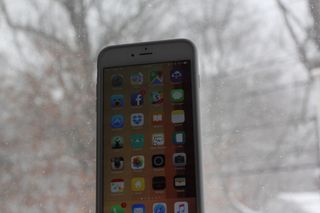How to keep your iPhone and Mac powered during Thursday's bomb cyclone


As someone who works at home with a decent backup supply of food and water, I don't have to worry much about driving or supreme amounts of shoveling, but I do consider my electronics. For one, iMore doesn't go dark during a blizzard unless our servers go down; also, there's the whole "keeping in communication with the outside world" bit that my mother tells me is so vital to our relationship.
Unfortunately, state officials have pretty much indicated that our power will likely be gone in the next 24 hours thanks to Thursday's impending "bomb cyclone" snowstorm. Before that happens, I'm running through my traditional electronics prep-list for freezing cold and potential power loss. If you're also in the path of the storm, hopefully these tips can help you, too.
Charge everything
Anything that can hold a charge and potentially connect to the interent (or power a USB device that can)? Charge it. This includes your current laptop, old laptop, and any external battery packs you may have lying around.
External battery packs (like my personal favorite, the Mophie Powerstation USB-C XXL can give your iPhone, iPad, or MacBook Pro extra juice when you need it most. If you don't have an external battery, you can also use an old laptop by leeching power from its USB ports; you may not use that old MacBook in your closet anymore, but its two-hour battery might be enough for one or two full charges of an iOS device.
Download podcasts and video now
Don't rely on Netflix or Spotify to save you from boredom if your power goes out. Streaming services will kill your battery faster than you can cry "uncle," especially if you tether your phone to your laptop.

Instead, download anything you're interested in watching or listening to ahead of time, while you still have battery power and a Wi-Fi connection. Your "Welcome to Night Vale{.nofollow}" addiction will thank you.
Make a friend who has a generator
If you absolutely need the kind of power that a battery pack can't provide, generators are the way to go. I don't own one myself — generators are expensive! — so instead, I've turned to the greatest resource a lady can have: her fellow home-owning friends.
Master your iPhone in minutes
iMore offers spot-on advice and guidance from our team of experts, with decades of Apple device experience to lean on. Learn more with iMore!
Chances are, if you live in the northeast and have buddies who own (or rent) a house, you probably know someone who owns a generator. And if you live in a house and want to be prepped for the future, there are lots of generator options you can take a gander at. (I'm going to send you to The Wirecutter's generator suggestions for more information, as generators are not my recommendation forté.)
Use a Kindle for Twitter news updates
This tip comes from my pal Rich, who used it to great effect during a big Northeast storm: If you have an older 3G e-ink Kindle lying around, you can save battery power on your iOS devices by using it to check Twitter for news updates and information.
You may also want to create a custom Twitter list of news organizations and local friends; you may tune out the rest of your feed (and their 70-degree west-coast weather bragging) but you'll save precious battery life skipping their tweets.
Dim your screens (and your radios)
Turn off the auto-brightness setting on your iOS devices and keep your screen dimmer than usual to save battery power. (You can do this by going to Settings > General > Accessibility > Display Accommodations > Auto-Brightness.) You'd be surprised how well you can still see and read with the screen at 30 or 40 percent brightness, and you can adjust this at any time by accessing Control Center.
It also might be worth turning off unnecessary wireless antennae, such as Wi-Fi and Bluetooth, or keeping your device in Airplane mode when you don't need to access the internet. And if you're worried about charging devices — use wired headphones, not wireless ones.
Can't get a signal? Try turning off LTE
If you, like me, happen to reside in a fairly populous city, cellular data networks can easily get overwhelmed during a power outage. Between tethering and everyone's reliance on cellular data, your formerly speedy LTE network could slow to a crawl. If you're on a GSM network (AT&T, T-Mobile, and their affiliates) you can avoid getting stuck in Internet molasses by dropping down to HSPA '4G' speeds, as fewer people are likely using those connection bands. (You can do this by going to Settings > Cellular > Cellular Data Options > Enable LTE > Off).

If you're on Verizon or Sprint, switching off LTE will drop you to 3G; in that case, it might still be worth dealing with the LTE bottleneck.
If cellular internet and voice lines are completely swamped and you need to get a message out, try SMS — it's typically the last of the networks to go, and the one the FCC recommends when communicating in non-emergency situations.
Avoid tethering
Cellular tethering from iPhone or iPad to Mac is wonderful, but it's a great way to drain both your laptop and iOS device's batteries. Unless you absolutely need to use the internet on your Mac, try to restrict it to the iOS device of your choice and use your Mac for offline tasks.
When in trouble, your car can save you
No battery packs? Out of juice? If you have a car and an inverter, you can recharge all your gear from your vehicle's 12V port. I'll note that this will run down both your car's battery and gas tank, so it may not be ideal, but it's an excellent last-ditch way to get some extra power while you're waiting for the lights to come back on.
Any other storm preparedness tips or tricks?
If you've got some other good tips for keeping your electronics happy and going during a big storm or power outage, I'd love to hear 'em. Slap them down in the comments while I go re-gas my car and get some food from the store.
Serenity was formerly the Managing Editor at iMore, and now works for Apple. She's been talking, writing about, and tinkering with Apple products since she was old enough to double-click. In her spare time, she sketches, sings, and in her secret superhero life, plays roller derby. Follow her on Twitter @settern.
Most Popular





